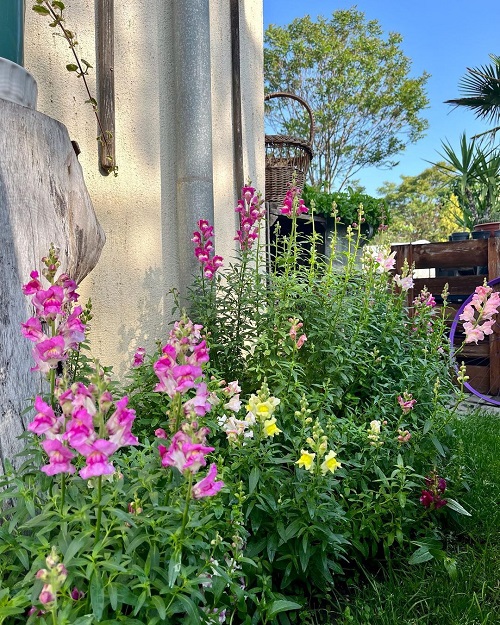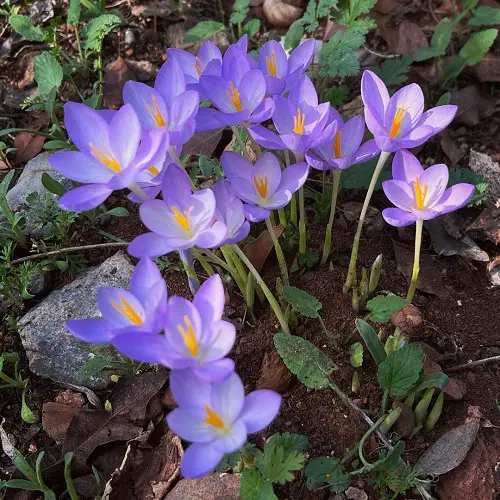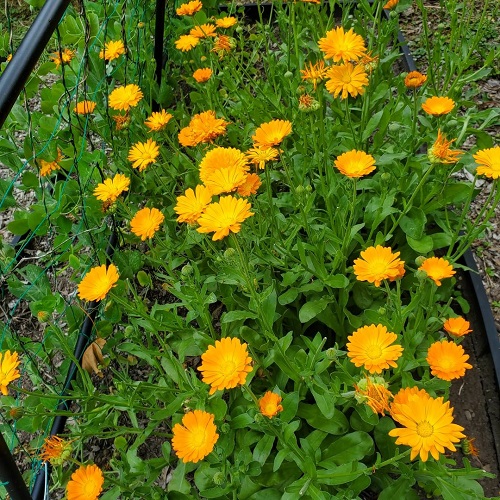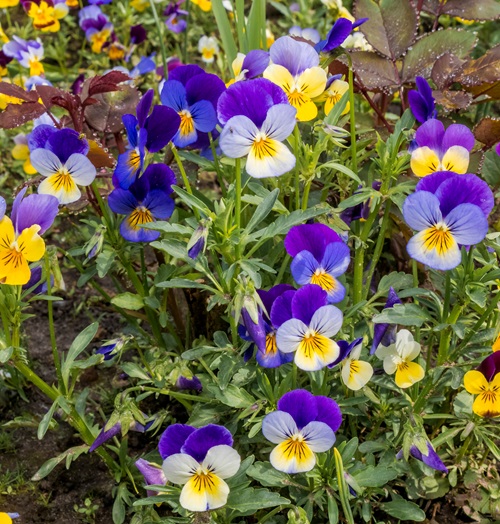Plan ahead with the Best Flowers to Plant in October! Set up your fall garden for stunning winter blooms that last through spring and beyond!
October is the perfect month to grow many cool-season flowers that often bloom through winter, spring, and summer! Some are frost-tolerant, while some are long-lasting—check out the best flowers to plant in the fall as the weather turns chilly!
Best Flowers to Plant in October
1. Tulip
Botanical Name: Tulipa
USDA Zones: 3-8
Tulips may remind you of spring, but the magic happens in October! This month is the perfect time to plant tulip bulbs in soil temperatures of about 32-55 F (0-13 C) so the roots flourish. They develop underground during the winter months and then bloom in spring.
Their upright cup-shaped blooms, with petals in almost every color except true blue, grow on sturdy stems. These flowers symbolize royalty and wealth and were once more valuable than gold in the 17th-century Netherlands!
2. Hyacinth
Botanical Name: Hyacinthus orientalis
USDA Zones: 4-8
For bright tubular hyacinth blooms in late winter to early spring, sow the bulb in the fall after the first frost but before the ground freezes. The bulbs will grow roots before it gets too cold, and then, the plant will gradually adapt and survive winter.
If sowing in containers, place the potted bulbs in a cold, dark room for about 8-10 weeks with an ideal temperature of 40–42 F (4–5 C).
3. Snapdragon
Botanical Name: Antirrhinum majus
USDA Zones: 7-11
Snapdragon blooms resemble a dragon’s snout that pops open and close. This winter-hardy flower takes time to grow, so start your seeds at least 12-16 weeks before the last frost. You can transplant once they have a few sets of leaves!
They can bloom through fall, spring, and mild summer, but snapdragons cannot tolerate drought and wither away in hot summers of warm climates.
For roots to sprout, these short-lived perennials need a balance between cold and warm, which October provides in several regions.
October is also the best time for planting if you live in a frost-free region, USDA Zone 10 and above, to enjoy its bloom in late fall, winter, and spring.
4. Primrose

Botanical Name: Primula
USDA Zones: 3-8
Primroses are perennials with lovely clusters of pink, purple, yellow, and white flowers. They cannot tolerate harsh full sun, extreme cold, or dry air, so the mild autumn weather of October is perfect for planting these sensitive flowers.
With equally stunning, waxy green foliage, primroses are one of the first to bloom in your garden—in late winter, at the end of January in several regions without harshest winter.
5. Crocus
Botanical Name: Crocus
USDA Zones: 3-8
Plant crocus bulbs in September and October for long-lasting blooms from late winter through spring. Fall is perfect for planting, as these bulbs barely take 4-6 weeks to produce roots and bloom quickly—sometimes with no sign of growth one day and blooms the very next!
Each bulb produces several blossoms that open with the morning sun and close by dusk or on a cloudy day. And if you’re growing Crocus sativus, you’re in for a treat, as the highly sought-after saffron is procured from the dried stigmas of this species.
6. Windflower
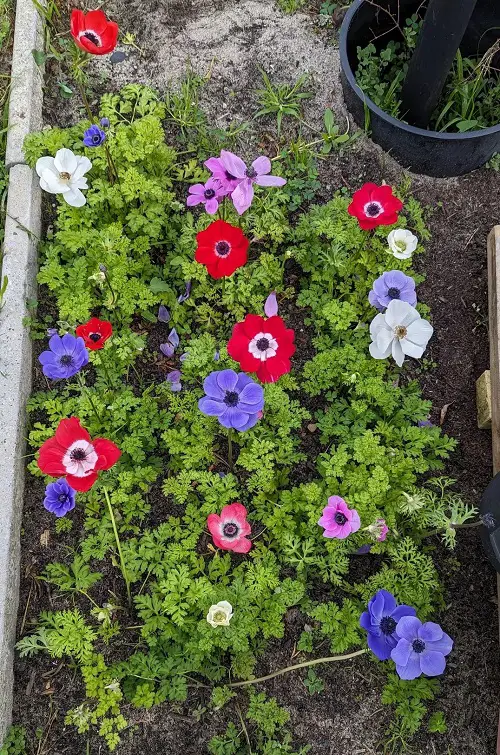
Botanical Name: Anemone
USDA Zones: 4-9
Anemones comprise over 200 species native to Asia, North America, and Europe. Because of this large group, each species has a different planting period. Out of them, Anemone blanda and Anemone nemorosa are perfect for October planting.
Most anemone bulbs need 3-4 months to produce flowers, so its daisy-like blooms will likely emerge in January and February, well into winter! Soak your anemone bulbs in lukewarm water for a few hours before planting them 2-3 inches deep in your garden soil.
7. Sweet Alyssum
Botanical Name: Lobularia maritima
USDA Zones: 5-9
Now, planting the sweet alyssum in October is reserved only for those who live in frost-free climes! This cool-season crop is usually grown just after winter ends and spring begins. Still, in regions with mild fall and winter, October is suitable for planting these flowers.
They will bloom in early spring and return in fall, so double the beauty! The sweet alyssum is an annual that will grace your garden with its white to purplish clusters of tiny, fragrant flowers.
8. Winter Jasmine
Botanical Name: Jasminum nudiflorum
USDA Zones: 6-10
While summer jasmine is planted in summer and early fall, winter jasmine is planted in late fall and winter. So, the chilly month of October is perfect for planting as long as the soil isn’t frozen solid.
This perennial shrub produces yellow flowers on long, trailing green stems. Its arching branches can be trained to climb or cascade over walls and fences. It will bloom from January to March, sprouting blooms even in the peak of winter!
9. Calendula
Botanical Name: Calendula officinalis
USDA Zones: 2-11
Calendula is a great choice for planting in October for those in the warmer zones of 8-10. This spicy-smelling flower thrives in mild temperatures, can handle light frost, and takes about 6-8 weeks to mature. Its blooms last from December until February!
To thrive, calendula needs well-draining soil, regular watering, and ample sunshine. It can also tolerate partial shade but hates wet feet!
10. Pansies
Botanical Name: Viola tricolor var. hortensis
USDA Zones: 2-9
Plant the hardy pansies early to mid-October so they root before the ground freezes completely! Producing blooms in 8-10 weeks after planting, pansies are known for their ability to flower through the winter.
They need rich, well-draining soil and should be planted in a location with full or partial sun. Pansies come in many pretty colors and bloom throughout December, January, and sometimes February. You should go with these icy pansies.
11. Stock
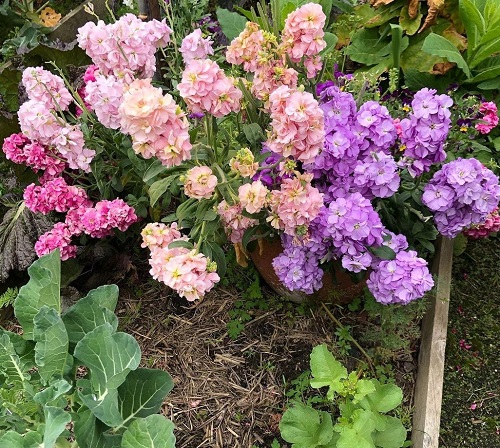
Botanical Name: Matthiola incana
USDA Zones: 6-10
Stocks are ideal flowers to plant in October if you want fragrant winter blooms and live in a climate with moderate winters. They produce pink, purple, white, and red flowers in late winter, typically around January or February, around 10-12 weeks after planting.
The plant is frost-tolerant, making it adaptable and hardy to a wide range of zones across the US. These flowers prefer well-draining soil and full sun but can tolerate partial shade.




